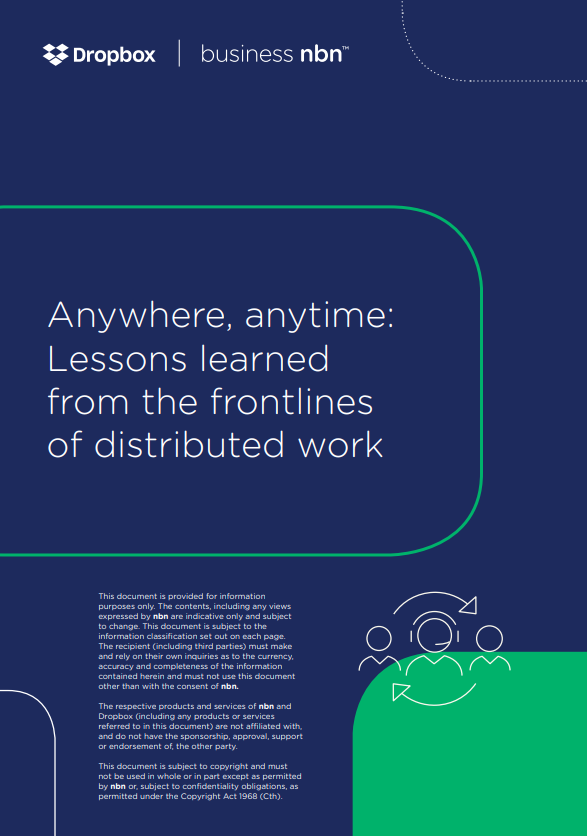
How SMBs can adapt to the new normal of distributed work
A new whitepaper from business nbn™ and Dropbox explores how businesses can use technology to stay connected and collaborative across distances.*
Flexible and remote working has been edging into mainstream workplaces since the 90s, but the COVID-19 lockdown was the first time Australia experienced remote working en masse.
Suddenly, businesses of all sizes had to quickly pivot their technology, people management and security practices to suit this new environment.
This large-scale phenomenon represents an accidental experiment with the concept of ‘distributed work’, where staff are geographically dispersed, with a central location acting as an ICT hub.

Collaboration is key to a remote workspace
The COVID-19 lockdowns have just about vanquished the myth that some jobs just can’t be done remotely, but bosses may still have to face the reality of a true collaborative model, where even choices in technology may be up for discussion, notes Dropbox’s Ewan Reid, head of channels ANZ.
“You really need to engage with your workforce about the platforms and the tools that they like to use. Don’t just think that this will be right for everyone. Listen to your staff and learn about where they naturally work best,” he says.
Digital tools that allow workers to ‘dip in and dip out’ and update their strategic and tactical goals help enable a flexible and collaborative environment. Technology and business consultant James Dellow calls it ‘working out loud’.
“It’s not necessarily [about people] working in real-time together. These tools make that information available so everyone knows what everyone else is doing,” he says.

Common challenges
It might be hard to believe, but the eight-hour working day is a relatively modern construct. Now the pandemic lockdowns have consigned this to the workplace rubbish bin. Dellow says to forget working 9 to 5: it’s what you do, not the hours you work.
“When you think about it, a physical workplace is a bit like the railways where you are trying to align with a clock. It’s coordinating and synchronising the cadence of the workday,” he says.
“That’s no longer your cadence. It’s not your control mechanism – you’ve got to find other mechanisms.”
Feelings of isolation are also a common challenge. In the past, remote workers have been in the minority, but “when you flip that around and everyone is working in a very distributed way, you can’t easily be connected to everyone else,” Dellow notes.
The key, he says, is using ‘digital place-making’ to create incidental meetings between staff. There are digital tools that help staff get together and mimic those water-cooler or coffee machine moments.

And with many employees logging in from home or elsewhere, network security is in the spotlight. It’s a fine balance between security and ease-of-use when implementing any new collaboration tools, but there are a variety of options available to help IT teams walk this line.
A secure network sets a strong foundation, so consider implementing technologies like a virtual private network (VPN), with additional features like multi-factor authentication for a proactive approach to security and risk management.
Dellow also advocates a good intranet, with photos and bios of everyone so staff know who’s who.
“It’s incidental, but you have to work hard on that, and you have to have the culture and the leadership skills to allow that to happen,” he says.
